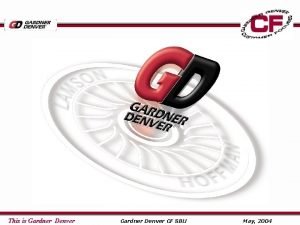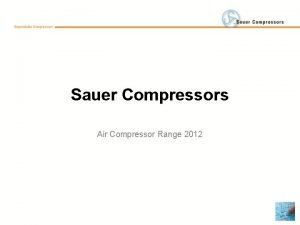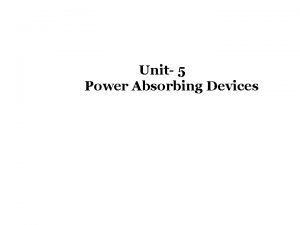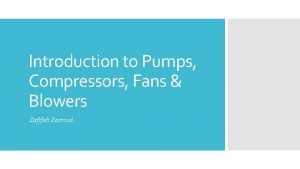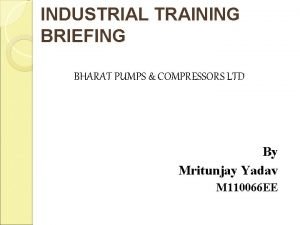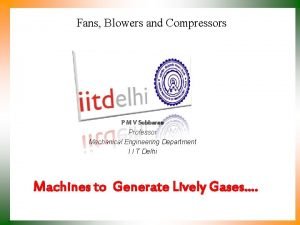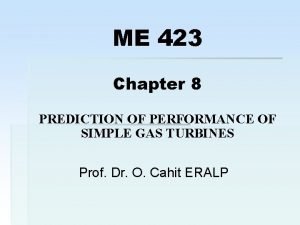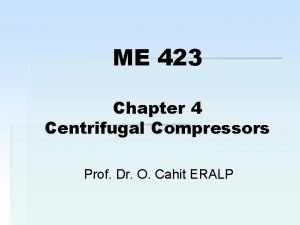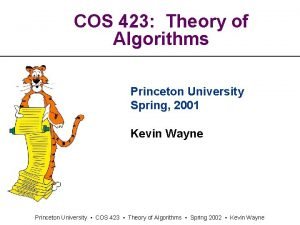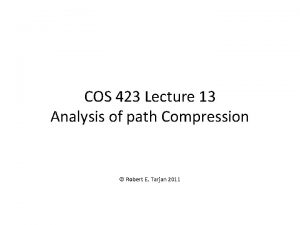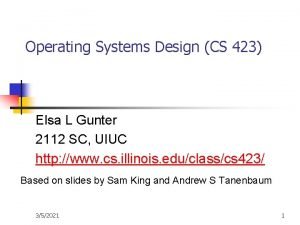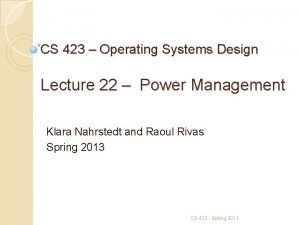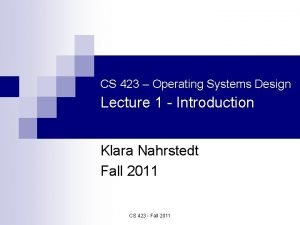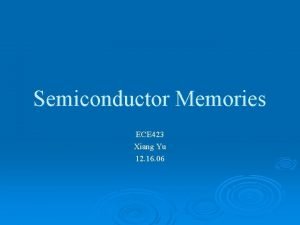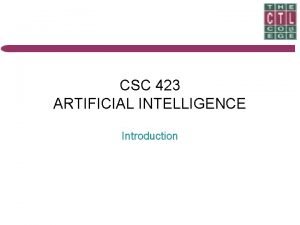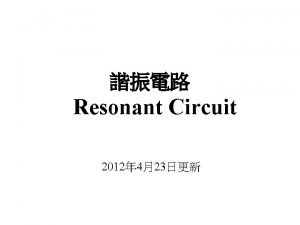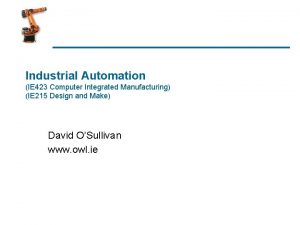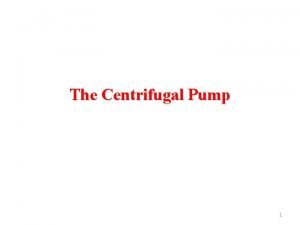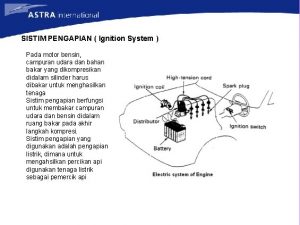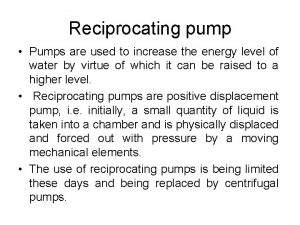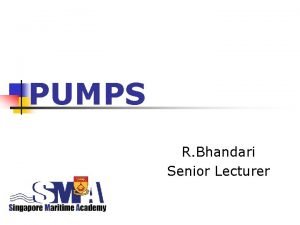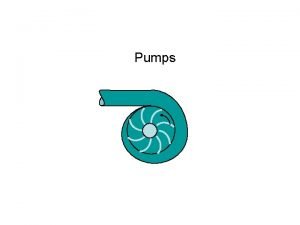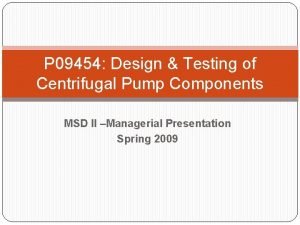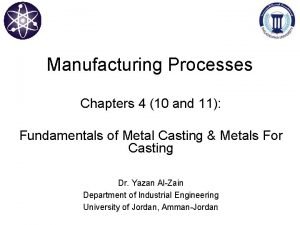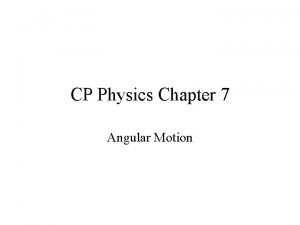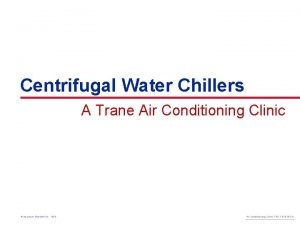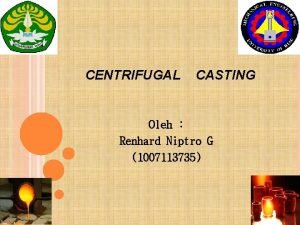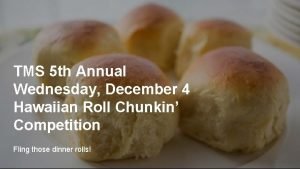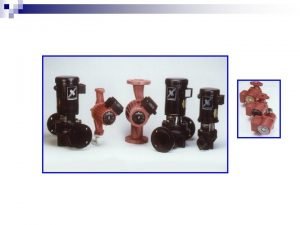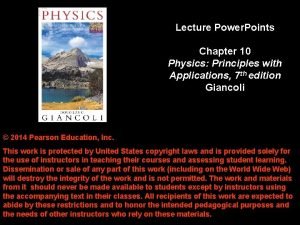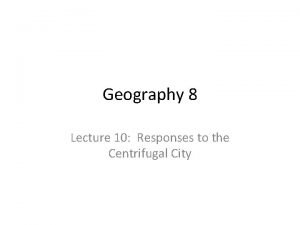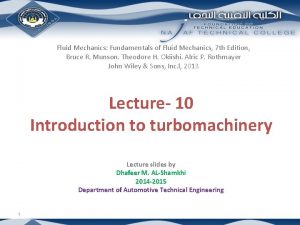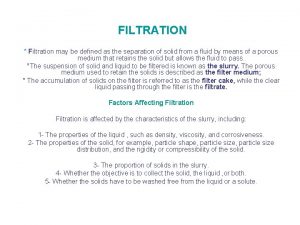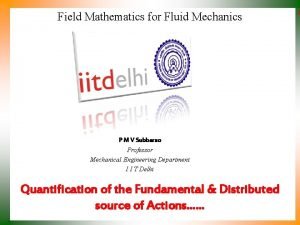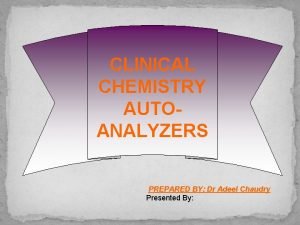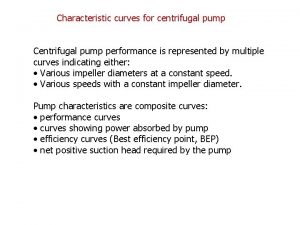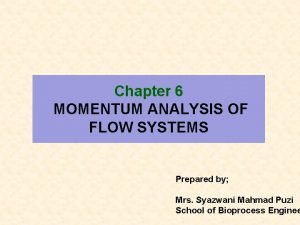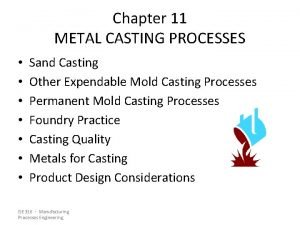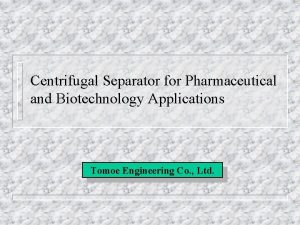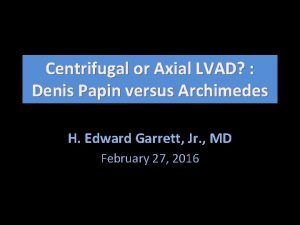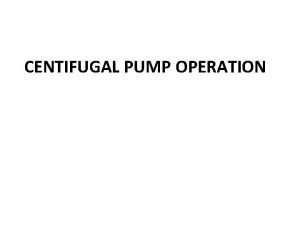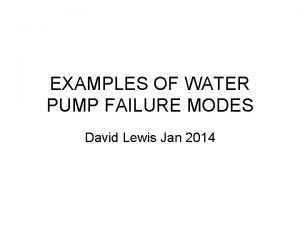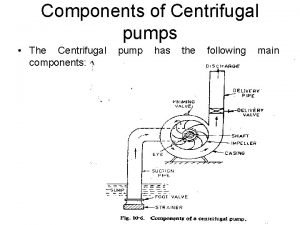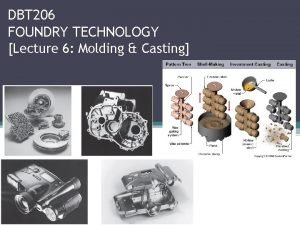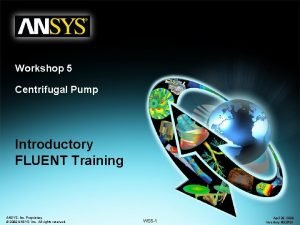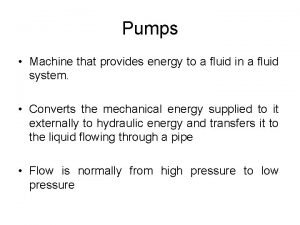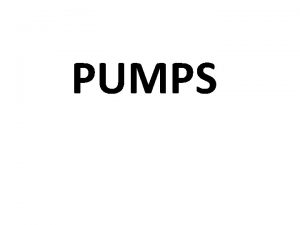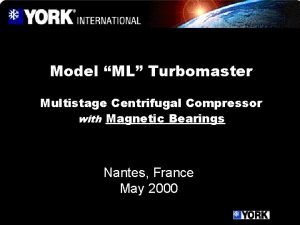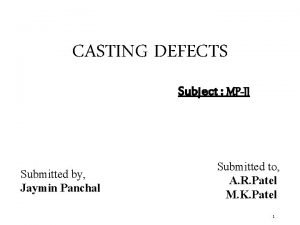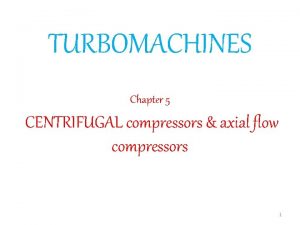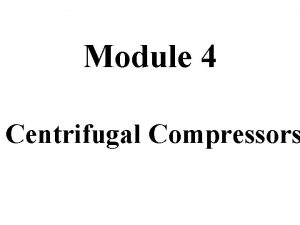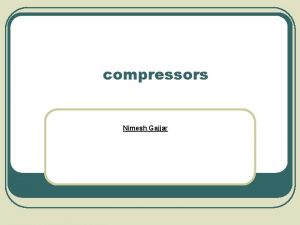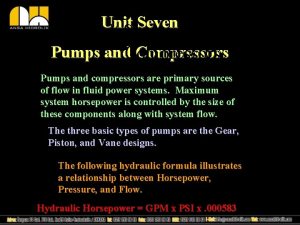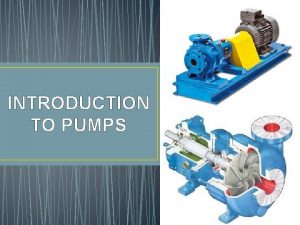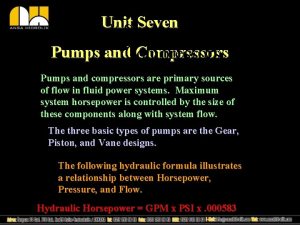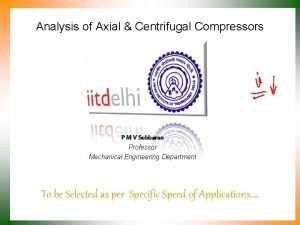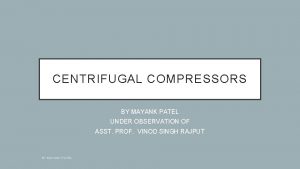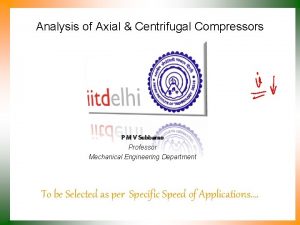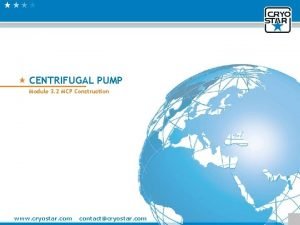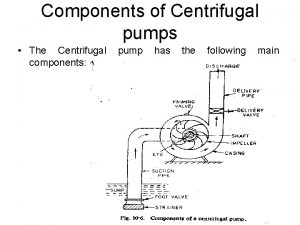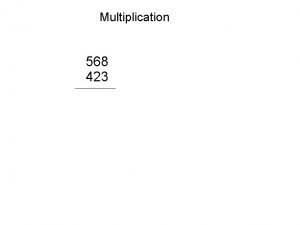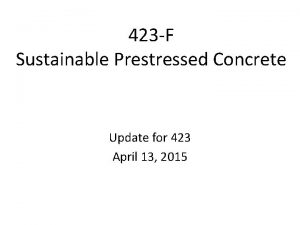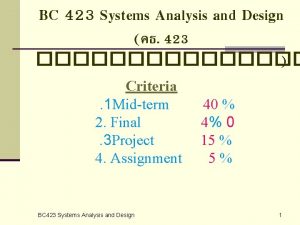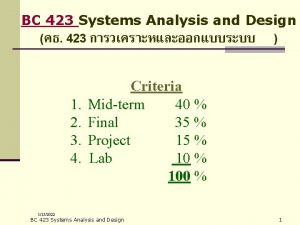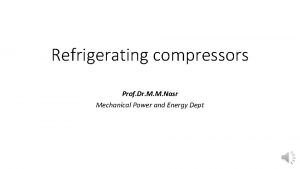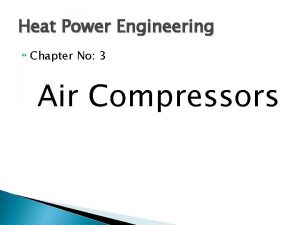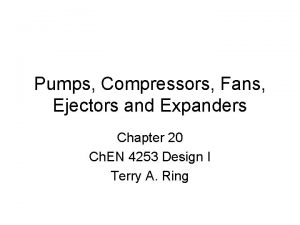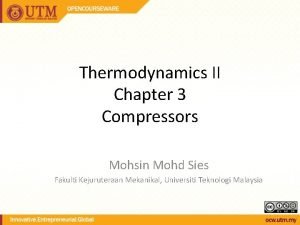ME 423 Chapter 4 Centrifugal Compressors Prof Dr











































































- Slides: 75

ME 423 Chapter 4 Centrifugal Compressors Prof. Dr. O. Cahit ERALP

Centrifugal Compressors 4. CENTRIFUGAL COMPRESSORS Attention was focused on the simple turbojet unit during the Second World War. It was recognized that development time was critical and much experience had been gained on the design of small high – speed centrifugal compressors for supercharging reciprocating engines. As power requirements grew for aircrafts, it became clear that the axial flow compressor was more suitable large engines. By the late fifties, it became clear that smaller gas turbines would have to use centrifugal compressors.

Centrifugal Compressors Advantages; § Primarily, suitable for handling small volume flows, § Shorter length than an equivalent axial compressor, § Better resistance to “Foreign Object Damage” (FOD), § Less susceptibility to loss of performance by build – up of deposits on blade surface, § Ability to operate over a wider range of mass flows at a particular rotational speed.

Centrifugal Compressors § A pressure ratio of around 4: 1 can readily be obtained from a single–stage compressor made of aluminium alloys. § The advent of titanium alloys, permitting much higher tip speeds, combined with advances in aerodynamics now permit pressure ratios of greater than 8: 1 to be achieved in a single–stage. § When higher pressure ratios are required, the centrifugal compressor may be used in conjunction with an axial flow compressor, or as a two–stage centrifugal.

Centrifugal Compressors 4. 1 PRINCIPLE OF OPERATION The centrifufal compressor consists essentially of a stationary casing containing a rotating impeller, which imparts a high velocity to the air and a number of fixed diverging passages in which the air is decelerated with the consequent rise in static pressure. The part of the compressor containing the diverging passages is known as the Diffuser. A increase ; V decrease ⇨ P increase

Centrifugal Compressors 4. 1 PRINCIPLE OF OPERATION Width of Diffuser Channel Vaneless Space Impeller Eye Diffuser Throat 90° Bend taking air to combustion chambers Mean Radius of Diffuser Throat

Centrifugal Compressors 4. 1 PRINCIPLE OF OPERATION § Air is sucked into the impeller eye and whirled around at a high speed by the values of the impeller disc. § The static pressure of the air increases from the eye to the tip because of the centrifugal effects. § The remainder of the static pressure rise is obtained in the diffuser, where high velocity air leaving the impeller tip is reduced.

Centrifugal Compressors 4. 1 PRINCIPLE OF OPERATION § The normal practice is to design the compressor so that about half the pressure rise occurs in the impeller and half in the diffuser. § Shrouds have been used on some superchargers but not in GT practice. § It should be noted that straight radial vanes are normally used because the impellers are very highly stressed.

Centrifugal Compressors 4. 2 WORK DONE & PRESSURE RISE § Since no work is done on the air in the diffuser, the energy absorbed by the compressor will be determined by the conditions of air at the inlet and exit of the impeller. § In the first instance it will be assumed that the air enters the impeller eye in the axial direction so that the initial angular momentum of the air is zero.

Centrifugal Compressors 4. 2 WORK DONE & PRESSURE RISE Ideal conditions at impeller tip V 2 VΘ 2 =U V 2 Vr 2 Eye Root Vr 2 Velocity relative to the impeller VΘ 2 < U ω (rad /s) Eye Tip r 1

Centrifugal Compressors 4. 2 WORK DONE & PRESSURE RISE § The axial portion of the vanes must be curved so that the air can pass smoothly into the eye. § The angle which the leading edge of a vane makes with the tangential direction β 1 will be given by the relative velocity of the air at inlet w 1.

Centrifugal Compressors 4. 2 WORK DONE & PRESSURE RISE V 2 : Absolute velocity with which the air leaves the impeller tip. Vθ 2 : Tangential or whirl component Vr 2 : Radial velocity component Under ideal conditions Vθ 2 = U

Centrifugal Compressors 4. 2 WORK DONE & PRESSURE RISE § Due its inertia, the air trapped between the impeller vanes is reluctant to move around with the impeller, and we have already noted that this results in a higher static pressure on the leading face of a vane than the trailing face. § It also prevents the air from acquiring a whirl velocity equal to the impeller speed. This effect is known as slip.

Centrifugal Compressors 4. 2 WORK DONE & PRESSURE RISE § Thus, slip is, how far the whirl velocity at the impeller tip falls short of the tip speed. § This depends largely upon the number of vanes on the impeller. § Greater the number of vanes, the smaller the slip. Vθ 2 ⇒ U as # of vanes (n) increase § § Slip Factor ; § an emprical relation;

Centrifugal Compressors 4. 2 WORK DONE & PRESSURE RISE § For unit mass flow of air, theoretical torque which is applied to the impeller : (theoretical torque/ ṁ) = Vθ 2 r 2 § Thus the work done on the air : (Wdone)theor = Vθ 2 r 2Ω = Vθ 2 U = σU 2 § Due to friction between the casing and the air carried around by the vanes, and other losses which have a braking effect such as disc friction or "windage“ ; the applied torque and therefore the actual work input is greater than this theoretical value.

Centrifugal Compressors 4. 2 WORK DONE & PRESSURE RISE § A power input factor "ψ" can be introduced to take account of this, so that the actual work done on the air becomes Work done = ψ σ U 2 ψ = 1. 03 1. 04 (typical value) § For an isentropic efficiency of ηc; (T 03 -T 01) = (T’ 03 -T 01)/ ηc

Centrifugal Compressors 4. 2 WORK DONE & PRESSURE RISE § Overall pressure ratio; So: § ψ and σ are neither independent of one another nor of ηc § ψ ⇨ frictional loss ⇨ degraded into thermal energy ⇨ net effect is an increase in outlet T. ψ decrease ⇨ η increase

Centrifugal Compressors 4. 2 WORK DONE & PRESSURE RISE § σ should be as large as possible. It is limited since the number of vanes (n) is limited. § As n increases the solidity of the impeller eye increases, the effective flow area decreases, which causes an increase in frictioanal losses. § So a suitable compromise must be found, and the present day practice is to use the number of vanes which will give a slip factor of about 0. 9. § The other factor that influence the pressure ratio are the tip speed U and the inlet temperature T 01. § T 01 depends on ambient conditions.

Centrifugal Compressors 4. 2 WORK DONE & PRESSURE RISE § Centrifugal stresses in a rotating disc are proportional to the square of rim speed. § For a single sides impeller of light alloy, U is limited to about 460 m/s by the maximum allowable centrifugal stresses. Such a speed yields a pressure ratio of 4: 1. § Higher compression ratios mean more expensive materials such as titanium alloys.

Centrifugal Compressors 4. 3. THE DIFFUSER § The problem of designing an efficient combustion system is eased, if the velocity of the air entering the combustion chamber is low. § It is therefore necessary to design the diffuser so that only a small part of the stagnation temperature at the compressor outlet corresponds to kinetic energy. § It is much more difficult to arrange for an efficient deceleration of flow than an efficient acceleration.

Centrifugal Compressors 4. 3. THE DIFFUSER § There is a natural tendency in a diffusing process, for air to breakaway from the walls of the diverging passage, reverse its direction and flow back in the direction of pressure gradient. § If the divergence is too rapid, this may result in the formation of eddies with consequent transfer of some KE into internal energy and a reduction in useful pressure rise. § Experiments have shown that the maximum permissible included angle of divergence of a rectangular channel with one pair of sides diverging is about 11 o. At angles greater than this, the losses increase sharply.

Centrifugal Compressors 4. 3. THE DIFFUSER § Diffusing flows (declerating) § Expanding Flows (Accelerating) § The angle of the diffuser vanes at the leading edge must be designed to suit the direction of absolute velocity of the air at the radius of the leading edge, so that the air will follow smoothly over the vanes. § As there is always a radial gap between the impeller tip and the leading edges of the vanes, this direction will not be that the air leaves the impeller tip.

Centrifugal Compressors 4. 3. THE DIFFUSER § To find the correct inlet angle for the diffuser vanes, the flow in the vaneless space must be considered. § After the air leaves the impeller (neglecting friction) Angular Momentum = Vq r = constant "in the vaneless Space“ § Vq decreases from the impeller tip to diffuser vanes (as r increase) § In accordance with the equation of continuity; Vr decreases with the increase in r. § The Net result : V decreases with increasing r.

Centrifugal Compressors 4. 3. THE DIFFUSER § When Vr and Vq have been calculated at the radius of the leading edges of diffuser vanes, then the direction of the resultant velocity " V " can be found, hence the inlet angle of the vanes. § Once the Number of Vanes and the depth of the passage have been decided upon, the throat width can be calculated to suit the mass flow required under given conditions of T and P. § The Length of the Diffuser passages will be determined by the maximum permissible angle of divergence and the amount of diffusion required.

Centrifugal Compressors 4. 3. THE DIFFUSER § After leaving the diffuser vanes, the air may be passed into a Volute and hence to a single Combustion Chamber "CC". For aircraft GT, each (or few) diffuser passage can be connected to a seperate "CC", or the stream could be fed into an "annular CC" surrounding the shaft connecting the Turbine compressor. Aθ θ C. G. _ r

Centrifugal Compressors 4. 4. COMPRESSIBILITY EFFECTS § We know that a breakdown of flow and excessive pressure loss can be incurred if the velocity of a compressible fluid relative to the surface over which it is moving reaches the speed of sound in the fluid. § When effort is made to obtain the maximum possible mass flow from the smallest possible compressor (as in aircraft practice), the air speeds are very high. It is of the utmost importance that the Mach numbers at certain points in the flow do not exceed the value beyond which the losses increase rapidly due to the formation of shock waves.

Centrifugal Compressors 4. 4. COMPRESSIBILITY EFFECTS § The “critical Mach number” is usually less than unity when calculated on the basis of the mean velocity of the fluid relative to the boundary because the actual relative velocity near the surface of a curved boundary may be in access of the mean velocity. As a general rule, unless tests indicate otherwise, The Mach numbers are restricted to about 0. 8. § At the intake, the air is deflected through a certain angle before it passes into the radial channels on the impeller. There is always a tendency for the air to break away from the convex face of the curved part of the impeller vane. Here then is a point at which the Mach number will be extremely important.

Centrifugal Compressors 4. 4. COMPRESSIBILITY EFFECTS § The Mach number is given by: Where T 1 is the static temperature at the inlet. Breakaway commencing at rear shockwave W 1

Centrifugal Compressors 4. 4. COMPRESSIBILITY EFFECTS U 1 Wq 1 a W 1 Vq 1 W 1’ Fixed inlet guide vane V 1 Va 1 Angle of prewhirl

Centrifugal Compressors 4. 4. COMPRESSIBILITY EFFECTS § It is possible to reduce the relative velocity w 1 and hence the Mach number by introducing Prewhirl at the intake. § This is achieved by allowing the air be drawn into the impeller eye over curved IGV's attached to the compressor casing, For the same axial velocity and hence approximately the same mass flow, the relative velocity is reduced as shown by the modified Velocity D. § This method of reducing Mach number, unfortunately reduces the work capacity of the compressor.

Centrifugal Compressors 4. 4. COMPRESSIBILITY EFFECTS § The air now has an initial whirl component Vq 1 so that, the rate of change of angular momentum per unit mass flow is : H = Vq 2 r 2 - Vq 1 r 1 if Vq 1 is constant over the impeller eye. § But the Mach number is only high at the tip of the eye. It is clearly preferable to vary the prewhirl, gradually reducing it from a maximum value at the tip, to zero at the root of the eye. This may be done if the IGV are suitably twisted.

Centrifugal Compressors 4. 4. COMPRESSIBILITY EFFECTS Impeller Exit: § It has been found that, as long as the radial velocity component is subsonic, Mach numbers greater than 1 can be used at the impeller without loss of efficiency. § It appears that supersonic diffusion can occur without the formation of shock waves if it is carried out at constant angular momentum with vortex motion in the vaneless space. § But if the Mach number at the leading edge of the diffuser vanes are rather high, and it would probably be advisable to increase the radial width of the VANELESS SPACE or the depth of the diffuser to reduce the velocity at that radius.

Centrifugal Compressors 4. 4. COMPRESSIBILITY EFFECTS § High M (at the leading edge diffuser) is not desirable because of air resonance considerations. § Static pressure differences around the circumference from due to locally high pressures at stagnation points. The danger is the instability created convects upstream causing mechanical danger as well as spoiling the flow. To take care of this the # of impeller vanes and diffuser channels are selected properly. § Exciting frequency f [rpm, # impeller vanes / # diffuser vanes] = a natural frequency of impeller channels. # diffuser channels are selected to be prime number # impeller vanes selected to be even number

Centrifugal Compressors 4. 4. COMPRESSIBILITY EFFECTS § As a result: The Vaneless space both § Decreases the danger of shock losses § Decrease the danger of excessive variations in static pressure due to Higher M near the impeller tip.

Centrifugal Compressors

Centrifugal Compressors

Centrifugal Compressors

Centrifugal Compressors

Centrifugal Compressors 4. 6. COMPRESSOR CHARACTERISTICS § The performance of a compressor may be specified by curves of delivery pressure and temperature (as a measure energy transfer) against mass flow for various fixed values of rotational speeds. § These characteristics (¢), however are dependent on other variables such as conditions of pressure and temperature at the entry of the compressor, and the physical properties of the working medium. § Any attempt to allow for full variations of all these quantities over the working range would involve an excessive number of experiments, and make concise presentation of the results impossible.

Centrifugal Compressors 4. 6. COMPRESSOR CHARACTERISTICS § Most of this complication may be eliminated by using the technique of “Dimensional Analysis” by which the variables involved may be combined to form a smaller number of more managable "Dimensionless Groups“ § By Dimensional analysis the following groups may be formed

Centrifugal Compressors 4. 6. COMPRESSOR CHARACTERISTICS § When we are concerned with the performance of a machine of Fixed Size, compressing a Specified Gas, R and D in the above groups may be omitted from the groups, Leaving Dimensional Groups such that § If these are the variables affecting the performance, it is only necessary to plot two sets of curves in order to describe the performance of a compressor (at a fixed speed) completely.

Centrifugal Compressors 4. 6. COMPRESSOR CHARACTERISTICS § P 02 /P 01 plotted vs for fixed values of § T 02/T 01 plotted vs for fixed values of § from these 2 sets curves it is possible to construct isentropic efficiency curves at constant speed.

Centrifugal Compressors 4. 6. COMPRESSOR CHARACTERISTICS Pressure Ratio po 25 /po 1 Surge Line 4 3 1. 0 0. 9 Locus of Points of Maximum Efficiency 0. 8 2 N/√To 1 Relative to Design Value 0. 7 0. 6 1 0 0. 2 0. 4 0. 6 0. 8 m√To 1/po 1 1. 0 1. 2

Centrifugal Compressors 4. 6. COMPRESSOR CHARACTERISTICS Isentropic efficiency ηc % 5 4 3 0. 6 0. 7 0. 8 0. 9 1. 0 N√To 1/po 1 (relative to design value) 2 1 0 0. 2 0. 4 0. 6 0. 8 1. 0 m√To 1/po 1 (relative to design value) 1. 2

Centrifugal Compressors 4. 6. COMPRESSOR CHARACTERISTICS § Consider what might be expected to occur when a valve placed at the delivery line slowly operated. Theoretically A : Valve is shut; m =0; P 02/P 01 pressure head (for the air trapped) B : h and P 02/P 01 is maximum C : All the power is absorbed in overcoming internal friction resistance (hypothetical case) In Actual Case Point A could be obtained if desired but most of the curve between A and B could not, owing to the phenomenon of SURGING.

Centrifugal Compressors 4. 6. COMPRESSOR CHARACTERISTICS Pressure ratio Theoretical Characteristics D B Constant speed curve A E Mass flow 1 0 C

Centrifugal Compressors 4. 6. COMPRESSOR CHARACTERISTICS § Surging is associated with a sudden drop in delivery pressure and with violent aerodynamic pulsations which are transmitted throughout the whole machine. § If we suppose that the compressor is operating at some point D on the positive sloped part of the ¢ , then a decrease in mass flow will be accompanied by a fall in delivery pressure. § If the pressure of air downstream of the compressor does not fall quickly enough the air will tend to reverse its direction and flow back in the direction of resulting pressure gradient.

Centrifugal Compressors 4. 6. COMPRESSOR CHARACTERISTICS § When this occurs, the pressure ratio P 02/P 01 drops rapidly. Meanwhile the pressure downstream of the compressor has fallen as well, so that the compressor will now be able to pick up again to repeat the cycle of events which occur at high (!) frequency. § Rotating Stall: When there is any non-uniformity in the flow or geometry of the channels between blades or vanes, a breakdown in the flow in one channel (say B), cause the air to be deflected in such a way that channel C receives fluid at a reduced angle of incidence.

Centrifugal Compressors 4. 6. COMPRESSOR CHARACTERISTICS § Channel A then stalls (air flow reduces) resulting in a reduction of incidence to channel B enabling the flow in that channel to recover. § Thus the stall propagates in a direction opposite to the blade rotation relative to the blades, from channel to channel. § This results in aerodynamic vibrations → fatigue failure. § Passage blockage → Loss of performance

Centrifugal Compressors 4. 6. COMPRESSOR CHARACTERISTICS

Centrifugal Compressors 4. 6. COMPRESSOR CHARACTERISTICS § Choking: On theoretical ¢ curve, actually point C can not be reached, since some where beyond point E the flow will be choked. (i. e. maximum possible flow rate. ) § The temperature ratio curve will be similar to the one forpressure ratio since § From P 02/P 01 and T 02/T 01 one can plot hc vs

Centrifugal Compressors 4. 6. COMPRESSOR CHARACTERISTICS § In some cases equivalent flow and equivalent speed are employed instead of the above Here: Generally: Tref = 288 o. K Pref = 1. 013 bar (ISA)

Centrifugal Compressors TURBINE CHARACTERISTICS § Similar to compressor ¢ Turbine performance is expressed in terms of similar dimensionless (or dimensional) groups § Turbine performance is plots are given by plotting vs for various

Centrifugal Compressors TURBINE CHARACTERISTICS § The efficiency plot is constant over a wide range of N and RT. This is because of the accelerating flow through the turbine blades permit an operation over a wide range of incidence without much loss. § The maximum corresponds to a choking condition at the existing pressure ratio. This choking might occur in the NGV nozzle (or sometimes at the outlet of the turbine depending on the design). § Even when unchoked, the constant curves do not seperate very much. Especially for multistage turbines, the curves converge to a single one. § This is very important especially for the part load performance of a gas turbine.

Centrifugal Compressors TURBINE CHARACTERISTICS

Centrifugal Compressors Problem on Centrifugal Compressors § A centrifugal compressor which is fitted to an aircraft has the following data; § § § § Mass flow rate of air Rotational speed Total pressure ratio Slip factor (σ) Power input factor Isentropic efficiency Inner radius of impeller eye Outer radius of impeller eye : : : : 6 kg/s 15000 rpm 4. 0 0. 9 1. 04 0. 82 8 cm 16 cm

Centrifugal Compressors Problem on Centrifugal Compressors § Ambient conditions Pa : 0. 3565 bar Ta : 236 K § Forward speed of the aircraft : 240 m/s § Inlet prewhirl(constant for all radii) : 300 § At the impeller exit blades are straight β 2 v= 900 FIND: a) Maximum Mach No at the impeller inlet b) Maximum Mach No at the impeller inlet for no prewhirl. For both a and b sketch velocity triangles c) The diameter of the impeller

Centrifugal Compressors Problem on Centrifugal Compressors d) Assume that meridional velocity is constant throughout the impeller, Vm 1= Vm 2 Va 1= Vr 2 § Find the impeller exit width b 2, sketch velocity triangles. e) If the diffuser inlet radius r 3= 1. 2 r 2 and the width of the vaneless space at the diffuser inlet is 2 mm in excess of impeller exit width, find the diffuser inlet Mach No.

Centrifugal Compressors Solution : 3 2 1 r 1 t r 1 h a) b 3 b 2 r 2

Centrifugal Compressors Solution :

Centrifugal Compressors Solution :

Centrifugal Compressors Solution :

Centrifugal Compressors Solution :

Centrifugal Compressors Solution :

Centrifugal Compressors Solution :

Centrifugal Compressors Solution :

Centrifugal Compressors Solution :

Centrifugal Compressors Solution :

Centrifugal Compressors Solution :

Centrifugal Compressors Solution :

Centrifugal Compressors Solution :

Centrifugal Compressors Solution :

Centrifugal Compressors Solution :

Centrifugal Compressors Solution :

Centrifugal Compressors Solution :
 Gardner denver blower division
Gardner denver blower division Lamellar valve (3rd stage)
Lamellar valve (3rd stage) Turbines are power absorbing device
Turbines are power absorbing device Fans blowers and compressors
Fans blowers and compressors Bharat pumps and compressors
Bharat pumps and compressors Fan blowers & compressors
Fan blowers & compressors Cse 423
Cse 423 Cse 423
Cse 423 Total pay card
Total pay card Brb 423
Brb 423 Me 423
Me 423 Me 423
Me 423 Cos 423
Cos 423 Princeton data structures and algorithms
Princeton data structures and algorithms Cos423
Cos423 Uiuc cs 423
Uiuc cs 423 Cs 423
Cs 423 Cs 423
Cs 423 Ai 423
Ai 423 Ece 423
Ece 423 Cont 423
Cont 423 Rlc
Rlc Sensors and actuators
Sensors and actuators Brine flotation technique advantages and disadvantages
Brine flotation technique advantages and disadvantages Structure of the
Structure of the Ignition system adalah
Ignition system adalah Reciprocating pump problems solutions
Reciprocating pump problems solutions Centrifugal pump working principle
Centrifugal pump working principle Axial flow pump example
Axial flow pump example Forward thrust capital ap human geography
Forward thrust capital ap human geography Centrifugal forces geography
Centrifugal forces geography Centrifugal pump testing
Centrifugal pump testing Types of centrifugal casting
Types of centrifugal casting Centrifugal casting formula
Centrifugal casting formula Centripetal vs centrifugal
Centripetal vs centrifugal How to calculate condenser approach
How to calculate condenser approach Centrifugal casting adalah
Centrifugal casting adalah Centrifugal catapult
Centrifugal catapult Pump curve basics
Pump curve basics Investment casting advantages and disadvantages
Investment casting advantages and disadvantages Radial flow centrifugal pump
Radial flow centrifugal pump New urbanism ap human geography definition
New urbanism ap human geography definition Fundamentals of fluid mechanics
Fundamentals of fluid mechanics Leaf filter advantages and disadvantages
Leaf filter advantages and disadvantages Radial flow centrifugal pump
Radial flow centrifugal pump Centrifugal analyzer principle
Centrifugal analyzer principle Affinity laws
Affinity laws Radial flow centrifugal pump
Radial flow centrifugal pump Centrifugal casting process steps
Centrifugal casting process steps Pharmaceutical centrifugal separator
Pharmaceutical centrifugal separator Denis papin centrifugal pump
Denis papin centrifugal pump Static suction lift of a pump
Static suction lift of a pump Zinc sulphate centrifugal flotation technique
Zinc sulphate centrifugal flotation technique Centrifugál szivattyú működési elve
Centrifugál szivattyú működési elve Centrifugal pump failure modes
Centrifugal pump failure modes Centrifugal pumps components
Centrifugal pumps components Expendable pattern casting
Expendable pattern casting Centrifugal pump training
Centrifugal pump training Centripetal movement geography
Centripetal movement geography Elongated state in africa
Elongated state in africa Centrifugal pump classification
Centrifugal pump classification Factors affecting pump selection
Factors affecting pump selection Vehicle mounted pumps
Vehicle mounted pumps York turbomaster compressor
York turbomaster compressor Homokformába öntés műveletei
Homokformába öntés műveletei Arise precision casting
Arise precision casting Prof. dr. marcus eckert
Prof. dr. marcus eckert Agamenon quimica
Agamenon quimica Prof david toback
Prof david toback Dr ali hossain
Dr ali hossain Prof suganda
Prof suganda Prof david kipping
Prof david kipping Tracce prova scritta tfa sostegno suor orsola benincasa
Tracce prova scritta tfa sostegno suor orsola benincasa Texte argumentatif exemple secondaire 4
Texte argumentatif exemple secondaire 4 Syzyfowe prace andrzej radek
Syzyfowe prace andrzej radek Prof. grace schneider
Prof. grace schneider
